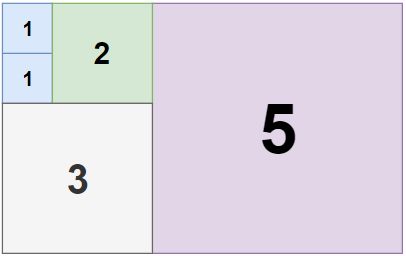题目描述
Given a rectangle of size n x m, return the minimum number of integer-sided squares that tile the rectangle.
Example 1:

Input: n = 2, m = 3
Output: 3
Explanation: 3 squares are necessary to cover the rectangle.
2 (squares of 1x1)
1 (square of 2x2)
Example 2:

Input: n = 5, m = 8
Output: 5
Example 3:

Input: n = 11, m = 13
Output: 6
Constraints:
1 <= n, m <= 13
算法1
(暴力枚举)
每次从左上角放正方形,然后把剩下的不规则图形分成不同类型的矩形。一共有三种分割方式:
1. 
2. 
3. 
时间复杂度
?
C++ 代码
class Solution {
public:
int tilingRectangle(int n, int m) {
if (n > m) return tilingRectangle(m, n);
vector<vector<int>> memo(n + 1, vector<int>(m + 1));
return helper(n, m, memo);
}
int helper(int n, int m, vector<vector<int>>& memo) {
if (n > m) return helper(m, n, memo);
if (n == 0) return 0;
if (n == m) return 1;
if (n == 1) return m;
if (memo[n][m] > 0) return memo[n][m];
int res = INT_MAX;
for (int i = 1; i <= n; ++i) {
res = min(res, 1 + helper(n - i, m, memo) + helper(i, m - i, memo));
res = min(res, 1 + helper(n, m - i, memo) + helper(n - i, i, memo));
for (int j = n - i + 1; j < m - i && j < n; ++j) {
res = min(res, 2 +
helper(n - i, m - j, memo) +
helper(i + j - n, m - i - j, memo) +
helper(n - j, m - i, memo));
}
}
return memo[n][m] = res;
}
};


老哥这三种分割方式怎么证明是完备的呀,,怎么想到的